This study investigated the effect of Quercetin on inflammation, bone loss, and cartilage health in a mouse model of osteoarthritis.
Key Findings
Quercetin showed several benefits in rats with osteoarthritis (OA):
- Prevented OA-induced knee cartilage degradation
- Reduced inflammation in circulation and in joint fluid
- Modulated levels of proteins to promote cartilage health
- Protected bones from OA-associated damage
Study Investigates Effect of Quercitin on Osteoarthritis (OA) in Rats
Thirty male rats were divided into five groups (n= 6/group):
- Control group: healthy rats receiving PBS
- OA group: OA rats receiving PBS
- L-dose group: OA rats receiving 25 mg/kg Quercetin
- M-dose group: OA rats receiving 50 mg/kg Quercetin
- H-dose group: OA rats receiving 100 mg/kg Quercetin
OA was induced in rats by an injection of monosodium iodoacetate (MIA) into the joint.
Rats received PBS or Quercetin intragastrically (directly into the stomach) once a day.
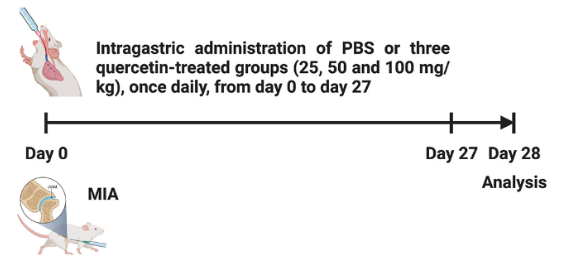
Experimental Design: OA was induced in experimental rats by injection of MIA in the right knee joint on Day 0. Rats received either PBS or their respective dose of Quercetin for the following 27 days.
Quercetin Prevented Osteoarthritis Progression
Quercetin supplementation protected cartilage on the knee joints from osteoarthritis (OA)-associated damage.
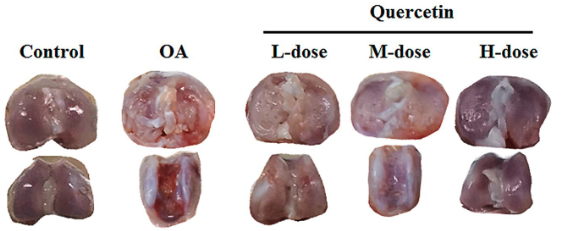
In the images above, knee joint samples from the study reveal distinct differences:
- Control Group: Cartilage in the Control group (without OA) is smooth and has a normal thickness
- OA Group: Cartilage in the rats with OA is rough and thin
- L-dose & M-dose Groups: Rats with OA that received low and medium doses of Quercetin had improved cartilage thickness and smoothness
- H-dose Group: Rats with OA that received a high dose of Quercetin had healthy knee cartilage, similar to the control group
Quercetin Reduced Inflammation in Blood and Joint Fluid
The researchers measured 22 inflammatory markers and growth factors in the blood and joint fluid of rats.
They found that the levels of inflammatory markers were significantly increased in the OA group compared to the healthy Control group.
High-dose Quercetin treatment prevented the OA-induced increase in inflammatory markers, while medium- and low-dose Quercetin treatment also reduced the increase, but to a lesser extent.
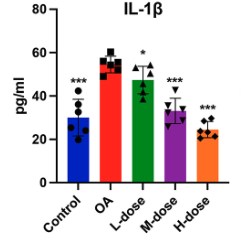
This figure displays the levels of IL-1𝛃, an inflammatory molecule in rat joint fluid.
OA rats (red bar) had higher IL-1𝛃 levels than healthy controls (blue bar), but low-dose (green bar), medium-dose (purple bar), and high-dose (orange bar) Quercetin-treated groups showed suppressed OA-induced increases of IL-1𝛃.
Quercetin Modulates Proteins to Preserve Cartilage Health
Quercetin treatments lowered the levels of cartilage-degrading factors that were elevated in the OA group, with high-dose Quercetin exhibiting the highest effectiveness.
The untreated OA rats showed low levels of aggrecan and collagen II, which can lead to cartilage compression. High-dose quercetin treatment effectively prevented this by preserving aggrecan and collagen II levels in OA-affected joints.
“Our results indicate a novel role of quercetin in preserving cartilage integrity by rescuing type II collagen and aggrecan from MIA-induced degradation.”
Quercetin Prevented Bone Damage and Bone Loss
OA has a significant impact on the subchondral bone, which is the bone directly beneath the cartilage in a joint, and the trabecular bone, which is the spongy bone inside the joint.
The figure below is divided into two sections, with the top part representing the subchondral bone, and the bottom part representing the trabecular bone.
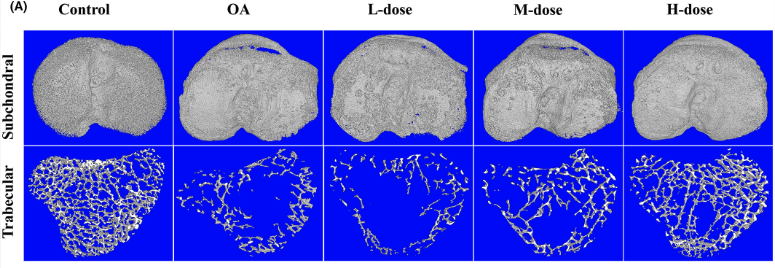
- Control Group: The leftmost column shows the control rats, which do not have OA. The subchondral and trabecular bone in these rats is healthy.
- OA Group: Next, the subchrondral bone of OA rats show significant formation of osteophytes (bony growths that form in OA that cause pain and stiffness). The trabecular bone in these rats is also significantly deteriorated.
- L-, M-, & H-dose Groups: Further to the right, you can observe the effects of Quercitin treatment on bone health. The higher the dose (L for low, M for medium, and H for high), the better the preservation of bone health. The H-dose Quercitin group, situated furthest to the right, is the most effective at improving both subchondral and trabecular bone health and are similar in apparence to the healthy control group.
Protective Effects of Quercetin Observed in an OA Rat Model
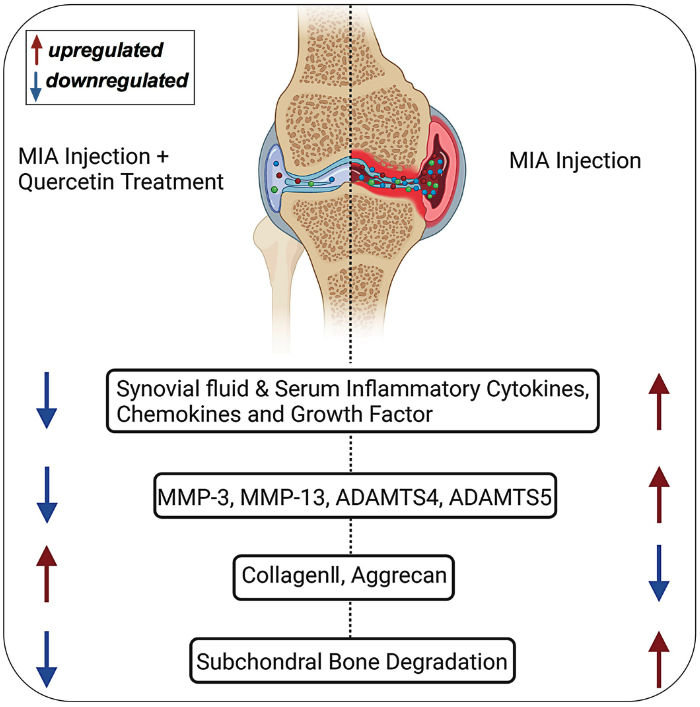
Image source: Quercetin prevents osteoarthritis progression possibly via regulation of local and systemic inflammatory cascades
This figure illustrates the effects of Querectin observed in this study. Quercetin protected against OA-induced damage by reducing inflammation, reducing proteins associated with cartilage degradation (MMP-3, MMP-13, ADAMTS4, ADAMTS5), increasing preventing the loss of protective proteins (CollagenII, Aggrecan), and reduced bone degradation.
Conclusion
This study showed that Quercetin protected rats with osteoarthritis against bone and cartilage damage by reducing inflammation and modulating levels of proteins associated with cartilage health.
“Our findings indicate that quercetin has a protective effect against OA development and progression possibly via maintaining the inflammatory cascade homeostasis.”
